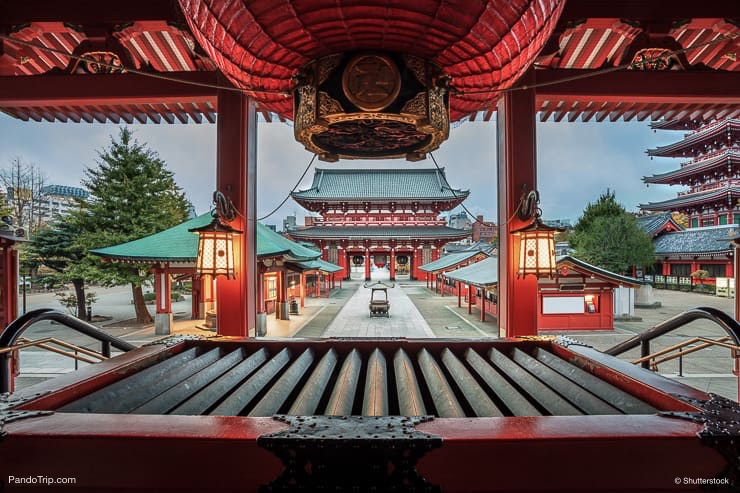You’re a thrill seeker, a globetrotter, a veteran traveler, and you’ve just landed in Tokyo. Now what? Past the ultra-modern facade of this famed East Asia city lies a number of beautiful, cultural, and certainly memorable cache of hidden gems. But where do you unearth such life-enriching treasure, you ask?
Well, the answer is easy: it’s waiting for you in one of Tokyo’s most beautiful, blossoming and historical neighborhoods: Asakusa. Asakusa holds a prime position in nearly every Tokyo guidebook, and for good reason! Not only does this old-school neighborhood (dating back to the Edo period) feature landmarks like the city’s oldest temple and some of the best street eats around, but many also say that just walking its hallowed, neon-free mom and pop style streets is a cultural experience in itself. Sound intriguing? If so, look no further, because we’ve got the best of the best of Asakusa must-dos coming your way.
1. Senso-ji
Topping our list of must-see sites is Asakusa’s commanding Senso-ji temple and its adjoining complexes. Senso-ji, also called Asakusa Kannon Temple after its neighborhood and foundation myth, is thirdly known as Tokyo’s Eiffel Tower by some, due to its historical and cultural significance (though possibly not due to its worldwide fame, for which Paris’ tower is unrivaled). Tokyo is hardly lacking in temples, but few can so robustly claim to be the oldest and most significant in the city’s history. In fact, Senso-ji temple actually outdates the city itself, with nearly a millennia and a half of history contained in its grandiose grounds. Though the modern facade and most of the buildings were reconstructed in the wake of World War II (including its entrance point, the stately Kaminarimon Gate), the site itself goes back to the 7th century.
Highlights of a temple tour include a picture with its large dragon fountain and/or cleansing oneself with its waters. Others opt for a round of inhaling the dense smoke from the nearby incense pot. However, the temple is quite popular so that perfect, crowd-free photo may prove a challenge.
Pro tip: Skip out on the crowds and visit Senso-ji at night. The main hall is closed from 5 pm, but all other sites are open all night and grant visitors a completely different viewing experience. The temple grounds are large, and an evening stroll can be just as pleasant as one taken in the daytime. The main hall, pagoda, Hozomon Gate and Kaminarimon Gate are illuminated from sundown to 11:00 p.m
Working Hours: Always open. The main hall is open from 6:00 to 17:00
Admission: Free
Website: www.senso-ji.jp
Location on map: Sensō-ji
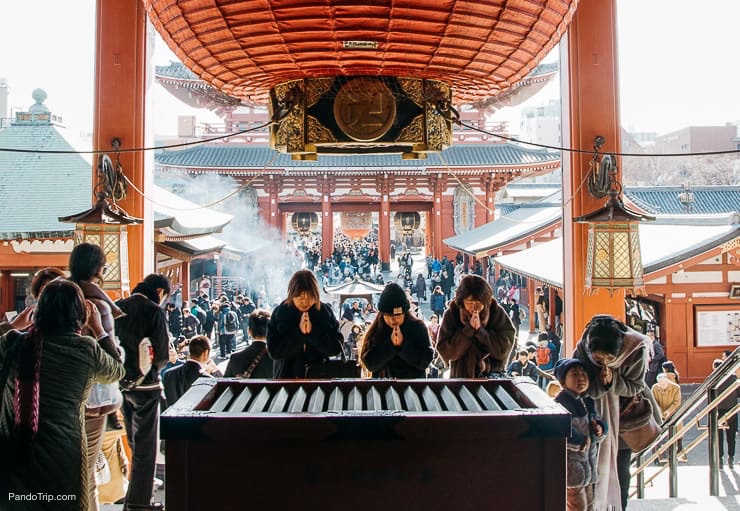
Praying at Senso-ji in Asakusa, Tokyo, Japan
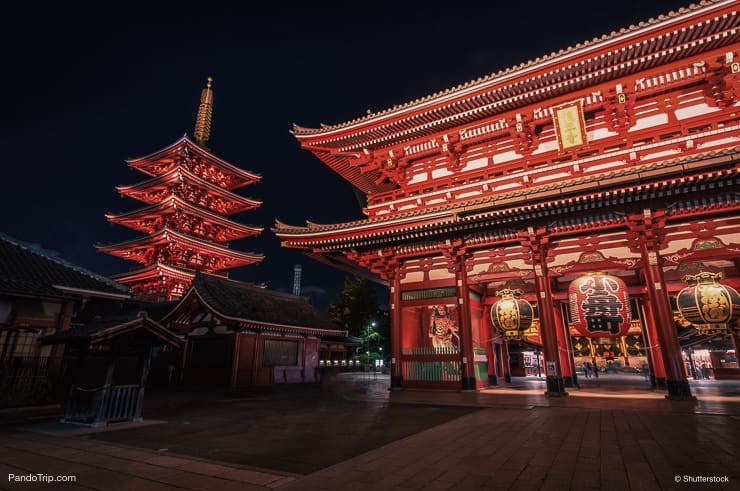
Senso-ji temple and The Five-Storied Pagoda at night
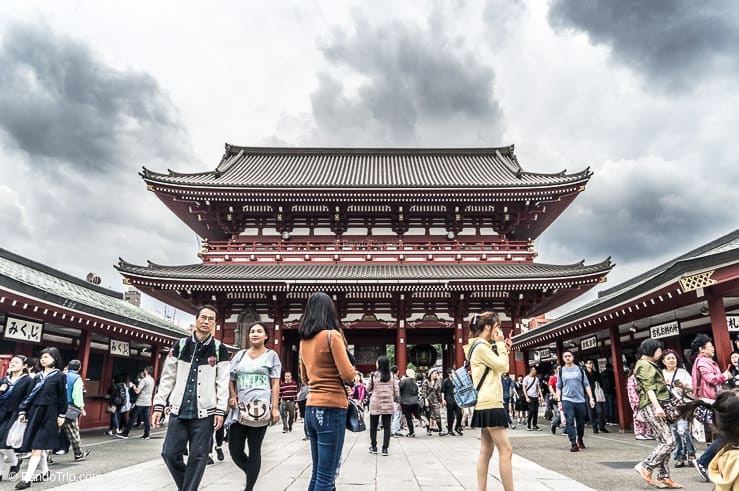
Sensoji temple on cloudy day
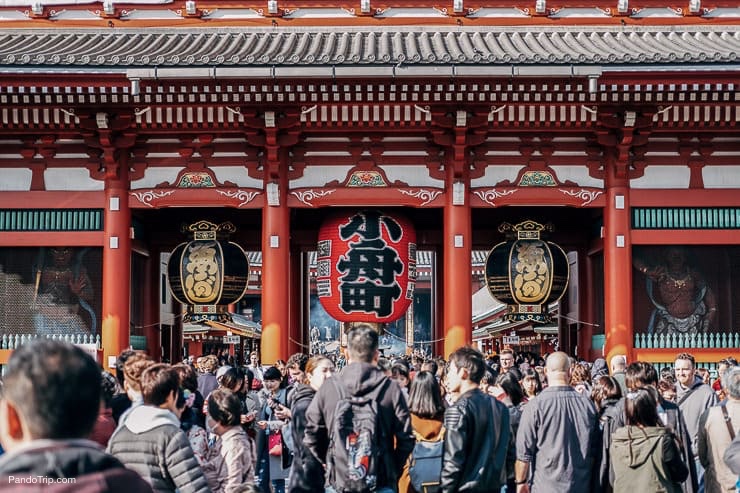
The Kaminarimon gates that leads to the Senso-ji in Asakusa, Tokyo, Japan
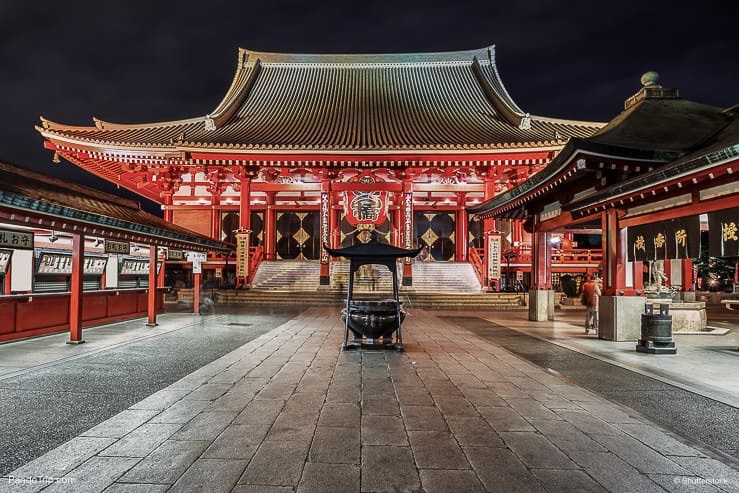
Famous Sensoji Temple in Asakusa, Tokyo
2. Get your grub on with Japanese food at Nakamise Dori
After your sojourn to Senso-ji, you may find your stomach rumbling. If that’s the case, hang a quick turn out the Kaminarimon Gate and you’ll find yourself on Nakamise Dori pedestrian shopping street, also known as one of Japan’s premiere “street eat” extravaganzas! This 250-meter long road is famous for its narrow, alley-like atmosphere as well as being jam-packed with nearly 100 separate shops, stalls and food stands. Though the vibe may seem new-age touristy, the history of the ramble goes all the way back to Edo pilgrim guides of the 18th century. So, if the idea of feasting “tabearuki” (aka walk-and-eat) style appeals to you, know that you’re not the first and certainly won’t be the last to pick up some of these world-class treats. Having trouble making up your mind? Try one of our favorites below:
1. Ningyo Yaki. A sweet cake filled with equally sweet red bean paste and folded into fanciful shapes with the help of molds, Ningyo Yaki is the most popular souvenir from Asakusa and a downright staple on Nakamise.
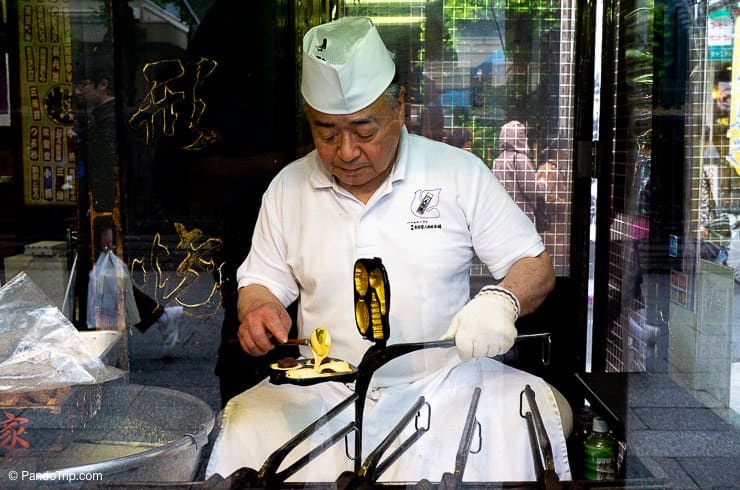
Making Ningyo Yaki at Nakamise Dori, Asakusa, Tokyo
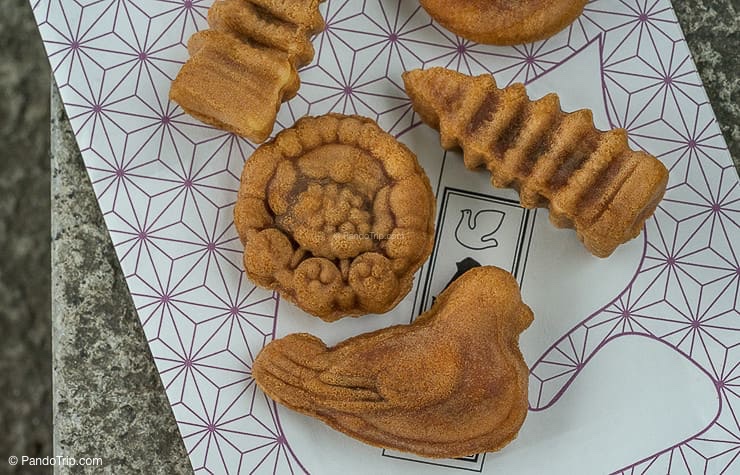
Ningyo Yaki
2. Kibi Dango. Kibi Dango is also a cake, but made of rice and covered with millet flour. It hails from the Edo period, and for that reason is considered to one of the most authentic old-timey confectioneries on the block. Visitors particularly love Kibi Dango Azuma in Nakamise street, where you can enjoy a Kibi Dango demonstration and try one that’s truly fresh off the presses.
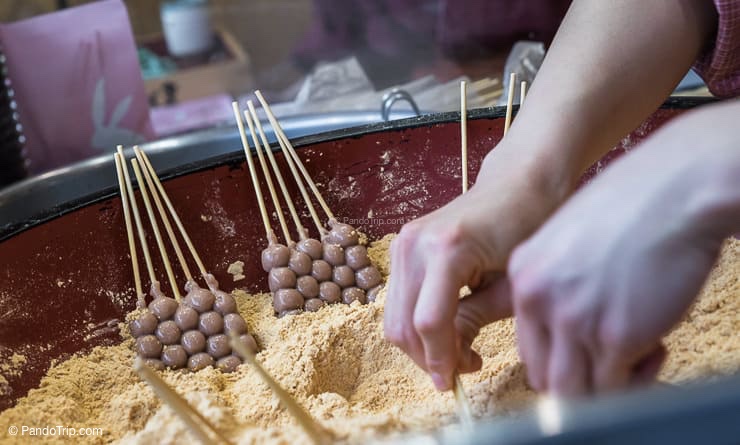
Kibi Dango at Nakamise Dori, Asakusa, Tokyo
3. Rice Cracker. The very best of the best rice crackers are waiting to be found in and around Nakamise. These babies are also sold in more flavors, sizes and even thicknesses here than you can dream of!
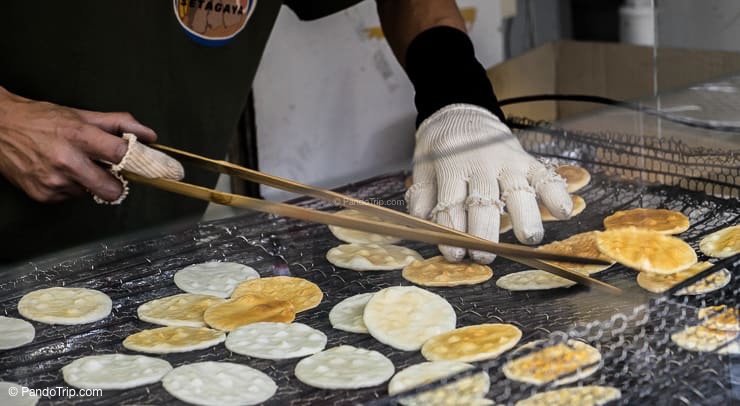
Making Rice crackers at Nakamise Dori, Asakusa
4. Imo Yokan by “Funawa” Imo Yokan, translated into English roughly as “sweet potato jelly,” is a traditional Japanese confectionery. But a local shop called Funawa is a not-so-secret-secret-spot for finding the absolute best, most authentic Imo Yokan (and other delectables) in town. Need another reason? Imo Yokan is also free from artificial additives, making it a crowd pleaser for the organic-enthusiasts among us as well.
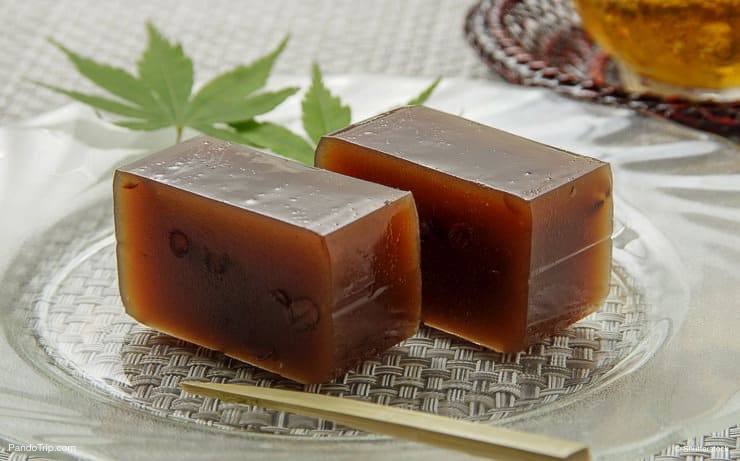
Imo Yokan by Funawa
Pro-Tip: Even if you’re not in the mood for some street eats, watching the process of how these yummy and often beautiful treats have been made for hundreds of years can fill your heart instead of your stomach.
Working Hours: Open Daily, 10:00 am – 5:00 pm (most stores)
Website: www.asakusa-nakamise.jp
Location on map: Nakamise Shopping Street
3. Savor the Very Best in Melonpan
In Asakusa you’ll find many things. But perhaps most importantly, you’ll be in the absolute optimal place to treat yourself to the world’s best melonpan!
Despite the misleading name, there is no melon in traditional melonpan. The misnomer refers rather to the large, voluminous shape of the sweet bun, as opposed to it’s filling. Traditional melonpan fillings are more akin to chocolate chips, matcha, or even ice cream. And though melonpan is sold under different names all over the world (and in fact, in several Japanese convenience store chains), you haven’t really lived until you’ve tried traditional melonpan from Kagetsudo. This small shop, which now boasts six locations in and around Asakusa, is one of the first makers of melonpan, and continues to create these delicious buns in the old style: with the perfect balance of butter and milkiness, and beautiful, melts-in-your-mouth crystalized sugar. Though melon buns from Kagetsudo run a little bit on the pricey side, at 220 yen for one, we promise, the investment is worth every cent.
Pro-tip: Kagetsudo’s original shop near the Kaminarimon gate sells over 3,000 melonpan buns a day, so it might be worthwhile to branch out into one of the newer locations, or at least prepare yourself for a line!
Honten Asakusa Kagetudo
Working hours: Open Daily, 9:00 am – 4:00 pm (or until sold out)
Website: asakusa-kagetudo.com
Location on map: Honten Asakusa Kagetudo (original store)
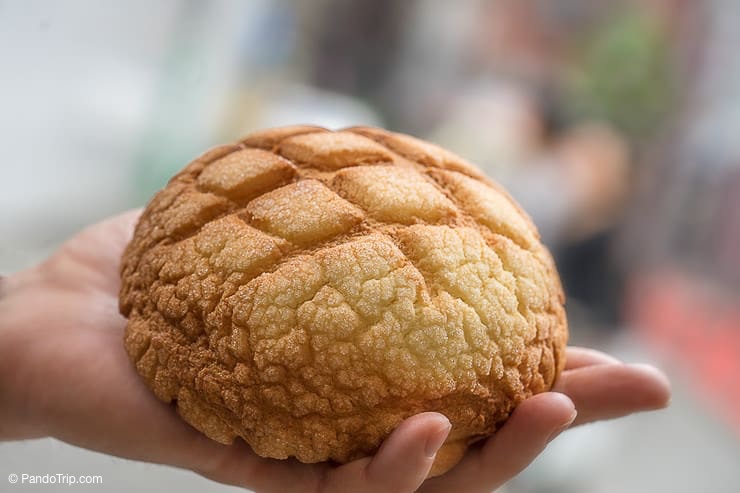
The Best Melonpan in the world from shop in Asakusa
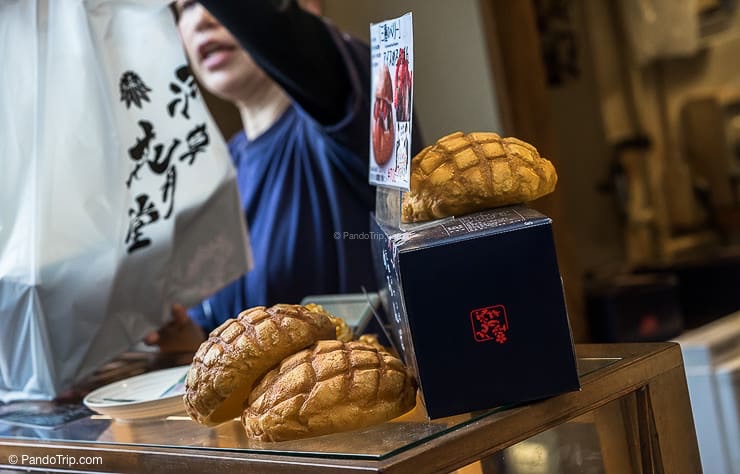
Melonpan Kagetsudos original shop near the Kaminarimon gate in Asakusa
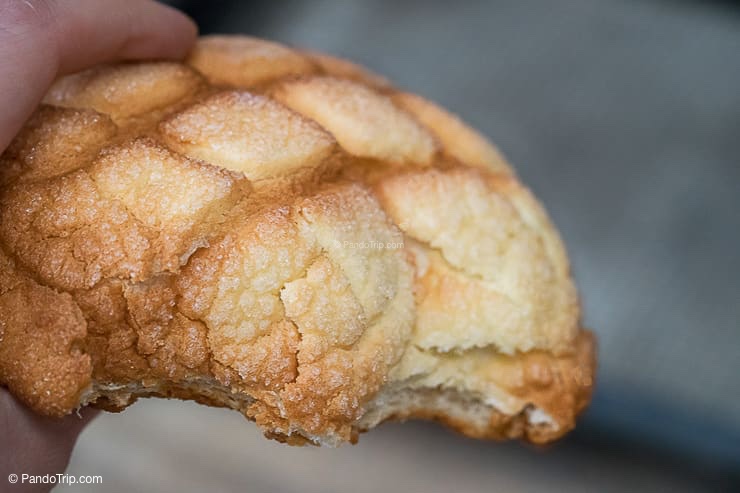
Famous Kagetsudos Melonpan in Asakusa
4. Get your fortune told at Senso-ji
So, you’ve found yourself at Senso-ji temple for a round of sightseeing, street eating, or giving alms to the Buddhist monks? But after all your temple scouting is said and done, how are you going to spend the rest of the day in the Senso-ji complex? After taking a beautiful walk around the grounds you might be interested in having a little good-natured peek into the future. Many people around the world take stock in getting their fortune told by the ancient mystics of a variety of cultures, so why should Japan be an exception?
The truth is, whether or not you believe in mysticism, getting your fortune told on Omikuji paper at Senso-ji is both fun and affordable. For the low low cost of 100 yen, you are given the chance to pick your own fortune out of a box located by the temple gates. If you pick a good one? Consider it an extra souvenir! And a bad one? Well, in that case, tie it to a nearby tree so evil spirits cannot follow you home. No harm, no foul. Just a little bit of mystical fun.
Pro-Tip: feel free to shake the box as much as you want, in hunt for that perfect fortune. And don’t worry if you can’t read the kanji, finding your box merely requires a little bit of “Eye-Spy” with the characters.
Working Hours: Always open
Admission: 100 yen
Location on map: Sensō-ji
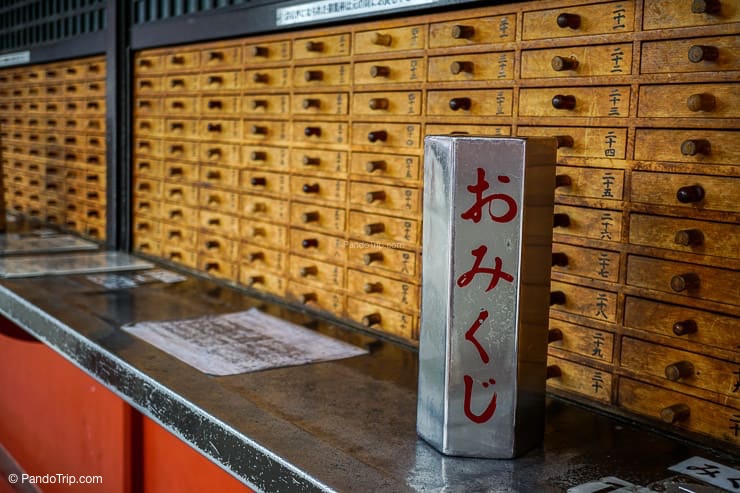
Fortune Box, Sensoji, Asakusa
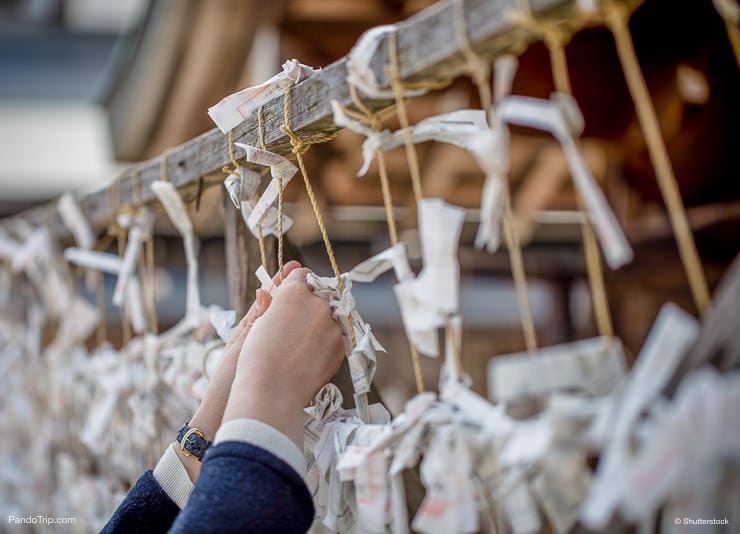
Omikuji fortune telling paper strip. People leave the omikuji behind if it’s not a good one
5. Ride on a Rickshaw
Nobody who visits Asakusa will tell you that it’s not walkable. But even so, the time might come where you need a little respite from a day of running around, temple-cruising and seeing sights. In that case, cue the rickshaw: your impromptu ride around the village for the afternoon. Asakusa, being the most historical neighborhood in the city, is actually the only place where you can hire an authentic rickshaw tour, aka a guide to squire you around the city on a make-shift bicycle taxi. Rickshaws were invented in the 19th century, as a precursor to taxis, and though they are not commonly used in Japan today, there are vestiges of the old-timey vehicles throughout Asia, including those waiting to whisk you around Asakusa.
Though thirty minute rickshaw tours through Asakusa are standard, and cost about $50 per person, longer and shorter rides are also available, allowing you to enjoy the neighborhood with your feet up to your heart’s content.
Pro-tip: Try to find a rickshaw through a tourist agency or rickshaw company, such as this online company. These guides are generally friendly, chatty, and speak great English, which makes for the most comfortable experience.
Admission: 8000 yen ($80) for two or 500 yen ($50) for just one person (30 Min Tour)
Location on map: Kaminarimon Gate
Order rickshaw online: Tokyo Asakusa Rickshaw Tour
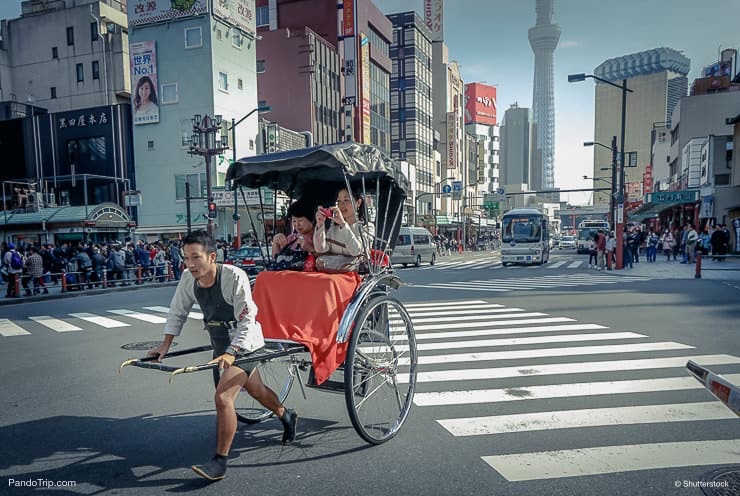
Rickshaw drove tourist around the Asakusa neighbourhood in Tokyo
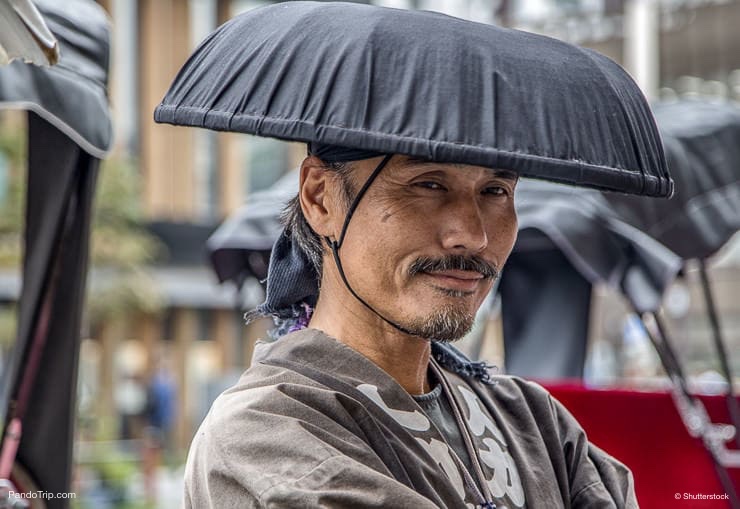
Rickshaw runner at Asakusa district in Tokyo, Japan
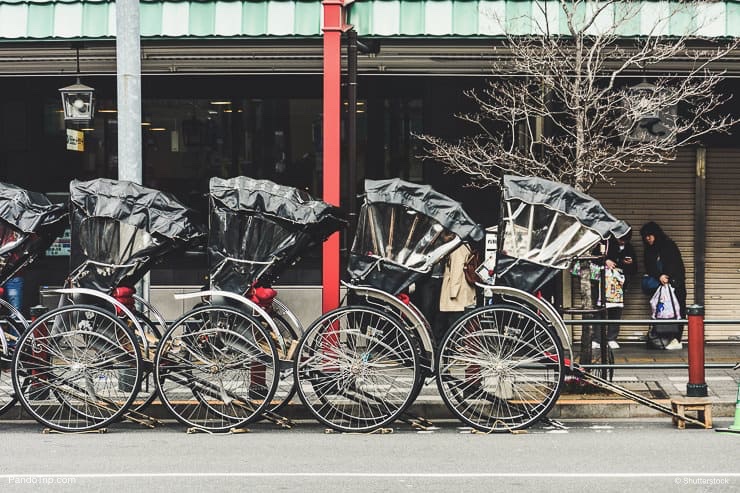
Row of Japanese rickshaws parking at the sidewalk on Asakusa road
6. Get a free bird’s-eye view of Asakusa
The Asakusa Culture Tourist Information Center is a delightful place to start or end your Asakusa journey. Start there to pick up some useful brochures and information on local sites and attractions, as well as engage with friendly English speaking staff who can answer questions about the neighborhood, culture, and logistics. However, the highlight of the Tourist Information Center is certainly the 8th floor observation deck, which hosts commanding views of the city, as well as the Tokyo Skytree across the Sumida River. You can even see the stately Senso-ji Temple from the Northern sector of the deck.
Pro-Tip: The Center also offers free wi-fi and power outlets for a midday recharge, in more ways than one.
Height: 128 ft (39 m)
Working hours: Open Daily, 9:00 am – 8:00 pm (Observation Terrace open until 10:00 pm)
Admission: Free
Website: www.city.taito.lg.jp
Location on map: Asakusa Culture Tourist Information Center
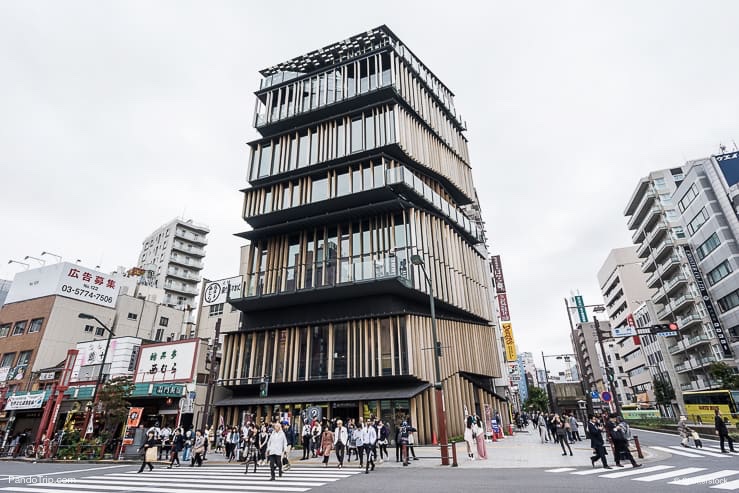
Asakusa Culture Tourist Information Center, Tokyo, Japan
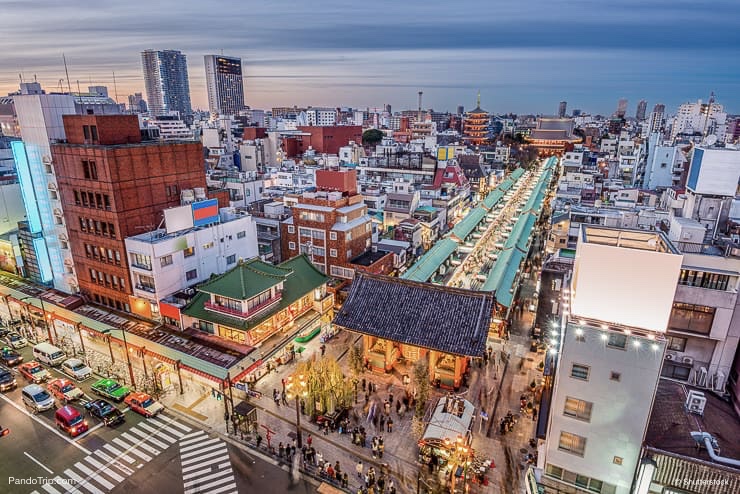
View of Nakamise-dori and Sensoji from Asakusa Culture Tourist Information Center, Tokyo, Japan
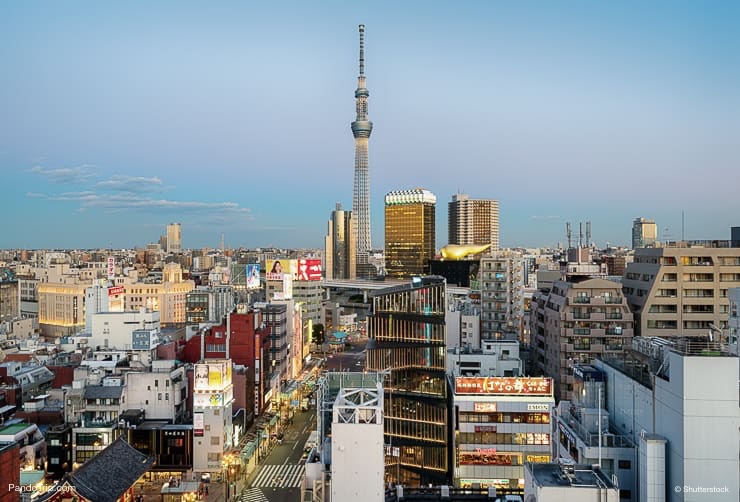
View of Tokyo Skytree and Asahi Beer Tower from Asakusa Culture Tourist Information Center, Tokyo, Japan
7. Taste the strongest matcha gelato in the world
Matcha Matcha Matcha. If there’s one edible thing that Japan has come to be known for its their famous “matcha green tea” flavor: found in everything from teas (both hot and iced) to kit-kats, coffee, and even ice cream. Matcha, which is simply a powdered form of green tea, has a long-running history of importance in Japanese culture. But where can a matcha enthusiast go to get the very best?
Suzukien is an easy answer. With its 150-year-old history, this teahouse brings a lovely balance of authentic Japanese style, with fun, new age foodie vibes. Though they offer a wide variety of traditional teas, from oolong to sencha, the main attraction here is definitely the one that might seem the least orthodox: matcha ice cream!
Suzukien’s take on this sweet treat comes in 7 different flavors, or, more appropriately, 7 different levels of intensity. While level one is a pleasant, matcha-infused ice cream, suitable for the faint of heart, level seven is famous for being the absolute strongest matcha flavored substance in the whole world. How’s that for a once in a lifetime sweet treat?
Believe it or not, this world-famous confection is fairly recent: having sprung from a partnership with matcha specialists Nanaya in only 2016. However, if current popularity is any indication, it’s clear that Suzukien’ matcha confectionary cream will be one for the ages.
Pro-tip: Not a fan of ice cream? As previously mentioned, Suzukien is also a world-class tea house. A stop by for a cuppa and a glance at the brave souls with their strong scoops of the green stuff is a great afternoon pit-stop in itself. Or else, find yourself in a group? In that case, we recommend getting a few different strengths and holding a blind taste comparison of your own.
Working Hours: Open Daily, 10:00 am – 5:00 pm (Closed every 3rd Wednesday of the Month)
Website: www.tocha.co.jp
Location on map: Suzukien Asakusa
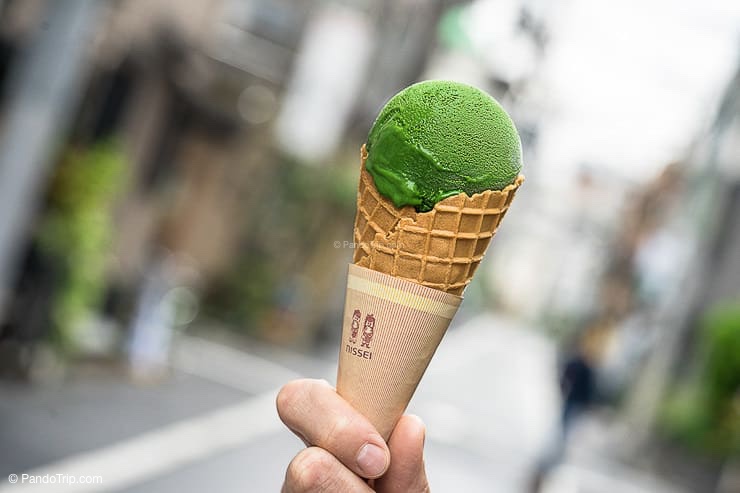
Strongest Matcha gelato in the world, Asakusa, Tokyo
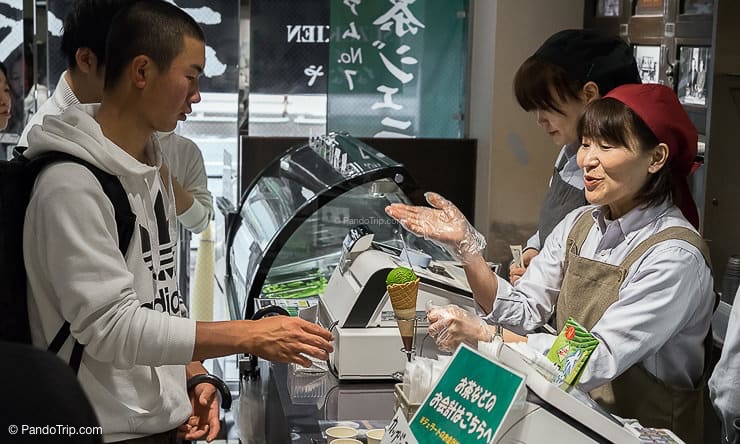
Suzukien in Asakusa. A place where you can taste the strongest matcha gelato in the world
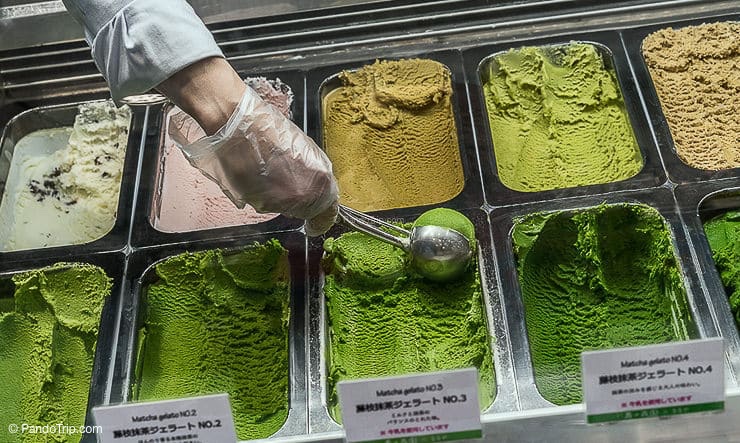
Strongest Matcha gelato at Suzukien in Asakusa
8. Catch a Glimpse of Tokyo Skytree – The Tallest Building in East Asia
Tokyo Skytree. Where have we heard that name before? Well, if you’ve been paying close attention to this list, you’ll see that The Skytree is one of Tokyo’s tallest buildings and most popular tourist attractions. But the Skytree is, in fact, more than that. It is the world’s second tallest building, clocking in at an impressive 634 meters. It is used as a communication tower and is built in the traditional Japanese “pagoda” style, giving it look that’s distinct enough to be universally recognized on sight.
But it’s also quite expensive. A basic ticket, which only goes up to the 350-meter deck, clocks in at 2,060 yen, and it’s another 1,030 yen for a shot at seeing the city from the Tembo Galleria.
Pro-tip: If you are truly interested in getting the most bang for your buck, up to a combo ticket for Tokyo Sky Tree will also buy an entrance to the nearby Sumida Aquarium.
Height: 2,080 ft (634 m)
Working hours: Open Daily, 8:00 am – 10:00 pm (entry until 9:00 pm)
Admission: 2060 yen ($20) for first observatory. Additional 1030 yen ($10) for second observatory.
Website: www.tokyo-skytree.jp
Location on map: Tokyo Sky Tree
Online Tickets: Tokyo Skytree & Sumida Aquarium Combo Ticket
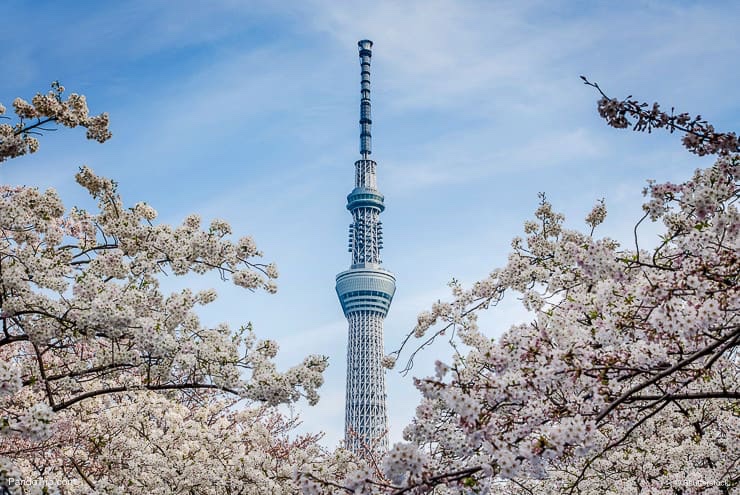
Tokyo Skytree with cherry blossoms in full bloom in Tokyo, Japan
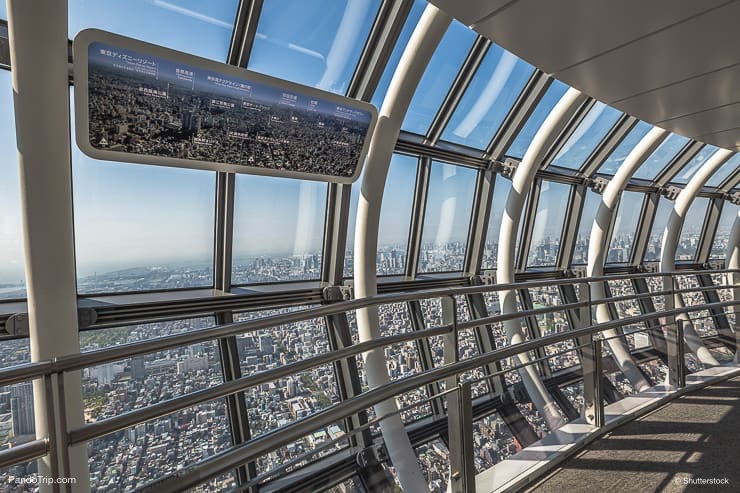
Tembo Gallery observation deck, the highest skywalk in the world. Tokyo Sky Tree
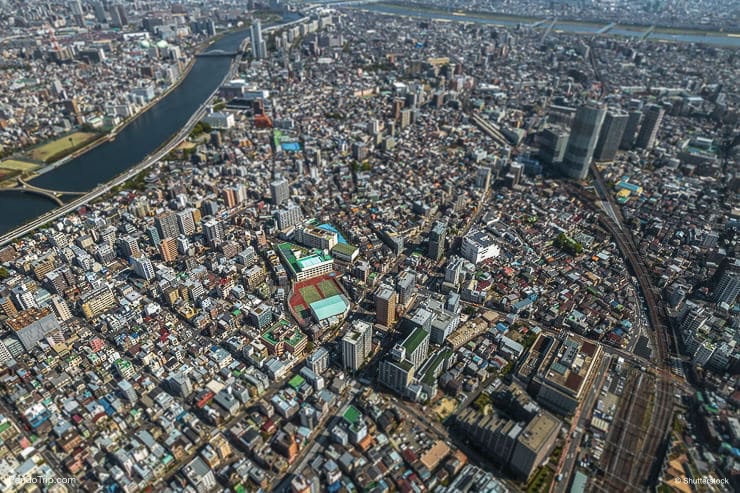
The view of Tokyo city from the top level of Tokyo Sky Tree, Japan
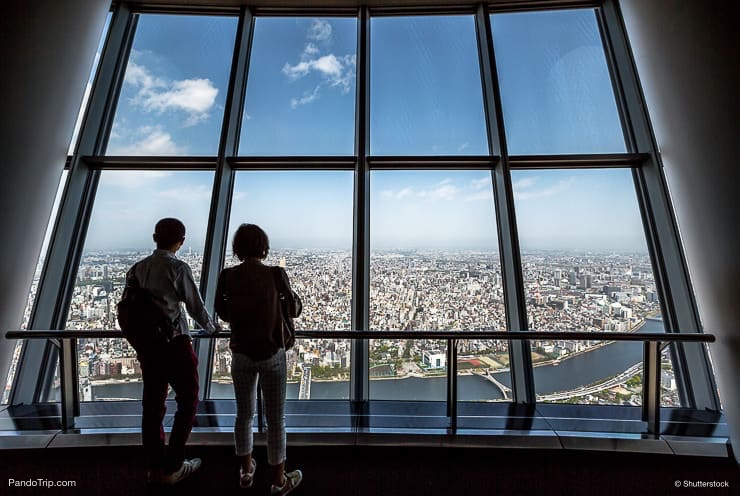
Tourists at Tembo Deck observation deck, Tokyo Sky Tree
9. Soak up the Sun in Sumida Park
Though it’s well-known to locals, Sumida Park’s beauty has gone, as of yet, untapped by the general tourist population. Located between the Azumabashi and Sakurabashi bridges, Sumida Park offers commanding views of the architectural wonders of the city (you can even see Tokyo Skytree from most angles) without all the hustle and bustle of downtown. All this makes it an absolutely fantastic place to spend an afternoon soaking up local culture and behaving like the locals do.
So, what do the locals do here? Many Tokyo locals come to Sumida in the springtime to watch the park’s 640 cherry blossoms in full-bloomed glory. Others come for a relaxing picnic or even a romantic stroll towards the river.
Pro-tip: On the last Sunday in July, the city hosts a fireworks festival in the park. If you find yourself in Tokyo in July, pack a blanket, some snacks and a sweatshirt for nighttime and get ready for the spectacular Sumida River Firework show! Fireworks not your style? The city also features riverboard cruises that depart from nearby and are a chance to see the scenic Sumida River in a whole new light.
Working Hours: Always open
Admission: Free
Location on map: Sumida Park
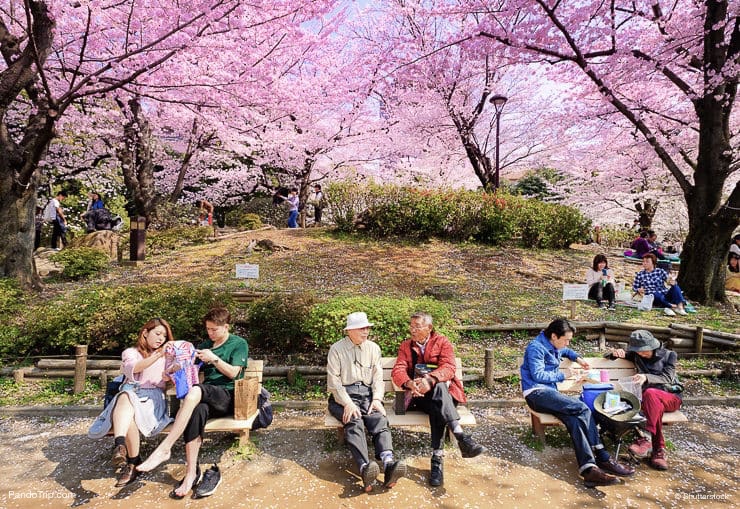
People enjoying cherry blossom at Sumida Park
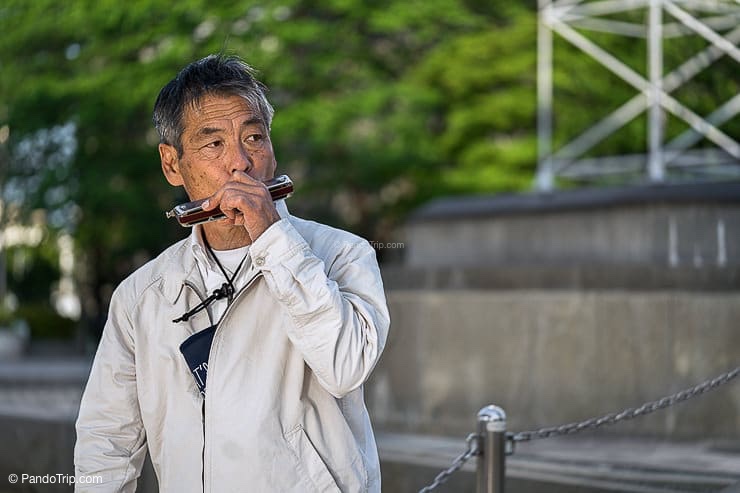
Japanese Man playing harmonica at Sumida Park
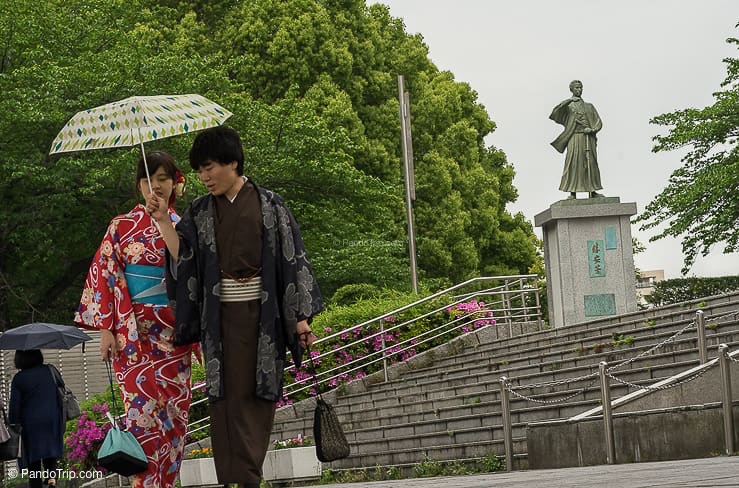
A couple walking at Sumida Park
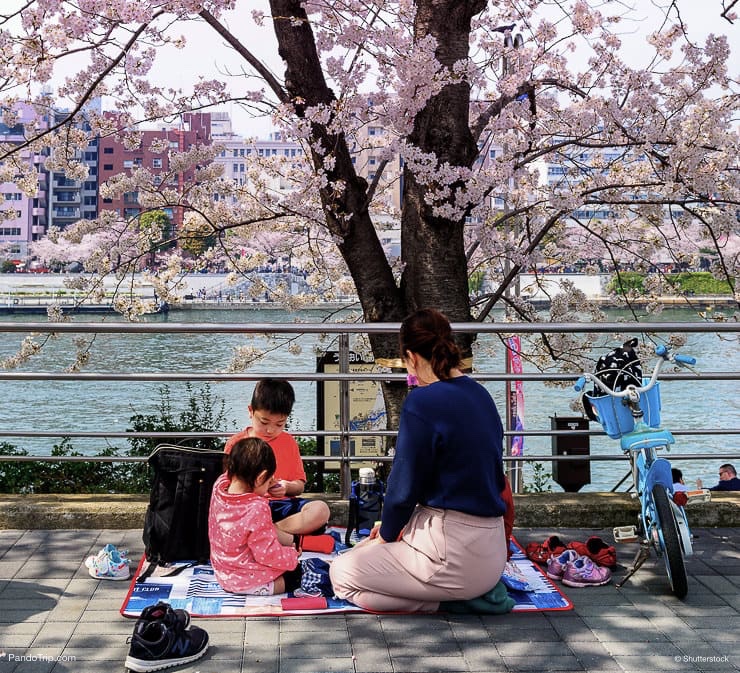
People having a picnic at Sumida Park
10. Go shopping in 100 yen shop
Many major East Asian cities boast a shopping scene that could make Cher Horowitz drool. And fortunately, Tokyo is no exception. Though the city boasts a ton of luxury shopping malls, bespoke tailor shops and jeweler’s worth their weight in gold, one of the most fun and whimsical aspects of shopping in Tokyo is popping into a classic 100 yen shop. These fun little shops (called hyaku-en in Japanese) act as a sort of mega-version of the American dollar store. Though, to be honest, the only thing that draws a comparison is the price. Japanese hyaku-en pride themselves on both the diversity of products sold and the quality.
In a hyaku-en, one can find nearly anything the heart desires, from beauty products to home goods to pet supplies. And though it’s easy to think of these shops as a sort of tourist trap, in recent years they have become a staple of Japanese consumer society in themselves. And for good reason! Where else can you buy a full stationery set for $0.90? 100 yen shops are located all over the city, but our favorite is Serie, a relatively new property that is housed in the sleek, modern Ekimise Shopping Complex on the Tobu Sky Tree line in Asakusa.
Pro-tip: The Ekimise Shopping Complex also features a pretty fantastic view of the Tokyo Sky Tree from its rooftop terrace. What a way to shop in style!
Working hours: Open Daily, 10:00 am – 8:00 pm
Website: www.seria-group.com
Location on map: Seria Asakusa, 5F, Ekimise Shop
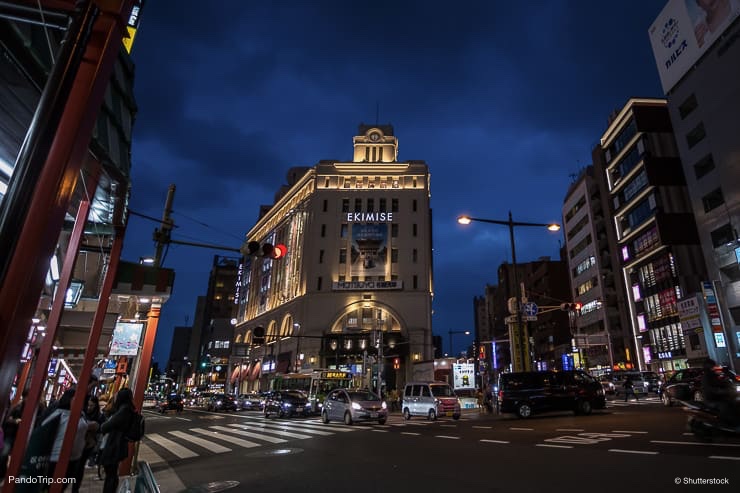
Ekimisi Asakusa, Shopping Center in Tokyo, Japan at night
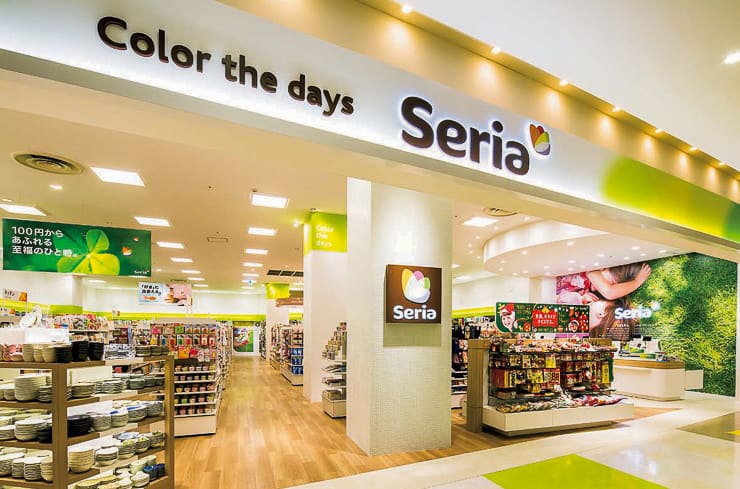
Seria, 100 Yen Shop in Japan
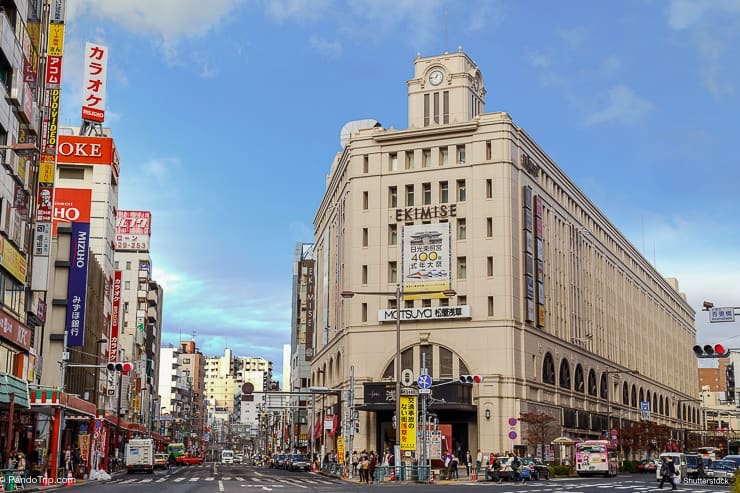
Shopping mall ‘Ekimise Asakusa’ in Tokyo
11. Snap a Selfie with a Golden…Turd?
The average wanderer, unfamiliar with the landscape of Asakusa, will by midday ask themselves (or perhaps those around them) about a rather unseemly site that’s caught their eye. This is because, in the center of this sector of the city stands the Asahi Beer Tower, a commanding structure that is crowned by a large sculpture, modeled after, well, a turd. Built in 1989, The Asahi Beer Tower is a functioning commercial/office building featuring a bunch of restaurants as well as the Asahi Craftmanship Brewery. The fact that this building is topped with a large glowing monument to number two (officially known as the Flamme d’Or) doesn’t seem to phase the locals, who in fact see it as one of the most iconic art and architectural landmarks in their city.
Pro-tip: If you fancy spending some quality time near your new golden friend, the Asahi Craftmanship Brewery features a nice array of (reasonably priced) lunch options to pair with their home-brewed artisanal beer.
Working hours: Restaurants open daily from 11:30 am to 10:00 pm
Website: www.asahibeer.co.jp
Location on map: Asahi Beer Hall
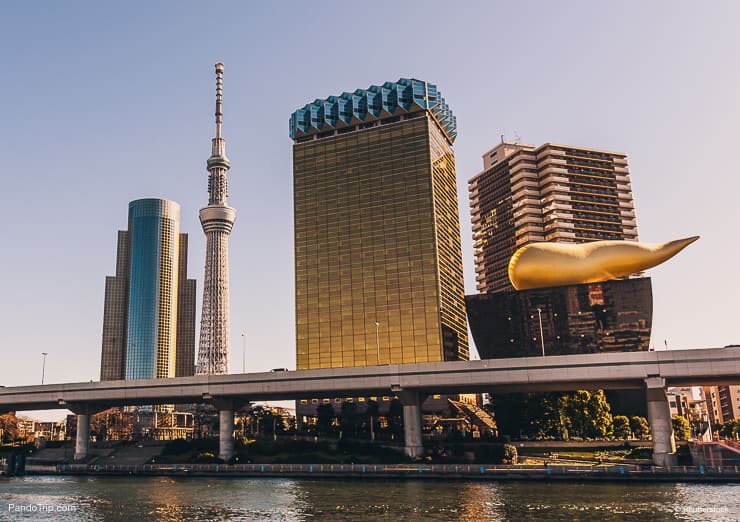
View of the Tokyo Skytree and the Asahi Beer Hall from across Sumida river
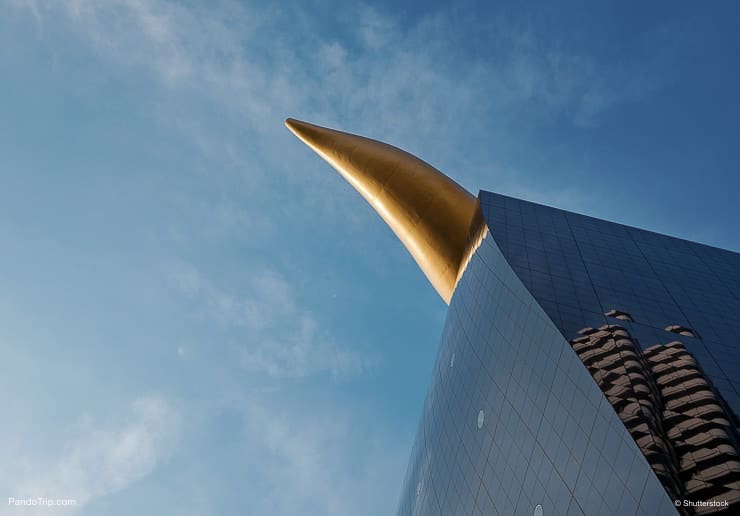
The Asahi Flame at the top of Asahi Beer Hall in Asakusa
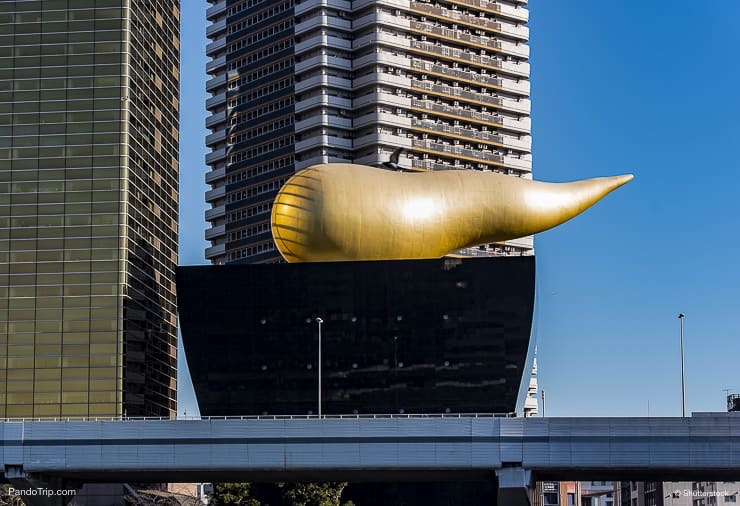
Asahi Beer Hall in Asakusa. Popular tourist spot
12. Visit traditional Japanese Izakayas at Hoppy Dori Street
Okay, Tokyo expert. Here’s a test for you: what in the world is an Izakaya? Anyone? Well, for those not in the know, an Izakaya is a traditional Japanese dive bar. But not just any old dive bar! Walking into an Izakaya on famed Hoppy Dori Street (also known as “Stew Street”) on a Saturday night, you won’t come away with a beer in your hand. Instead, you’ll be able to take in the sheer alcoholic delight of hoppy. Hoppy, though in some ways similar to beer, is a malt-based alcoholic beverage that’ll run you a cheaper price tag and bestow upon you a more authentic experience than its more Westernized counterpart.
Sound intriguing? Well, then, get yourself to Hoppy Dori Street. Located quite near the Senso-ji complex, Hoppy Dori is an Asakusa alleyway running about 80 meters and jammed packed with Izakaya pubs as far as the eye can see. And how will you know an Izakaya when you see one? Keep an eye peeled for some rickety outdoor bar stools, menus with pictures instead of words, and of course, freshly brewed hoppy adorning the tables of locals and tourists alike.
Pro-tip: Just be warned, the food you’ll find on Happy Dori is mediocre, and not everyone loves the distinct taste of hoppy. We recommend going more for the cultural experience than for its culinary delights.
Working hours: The best time to go here is from 5:00 pm to 23:00 pm, but some places will work from 9:00 am
Location on map: Hoopy Dori
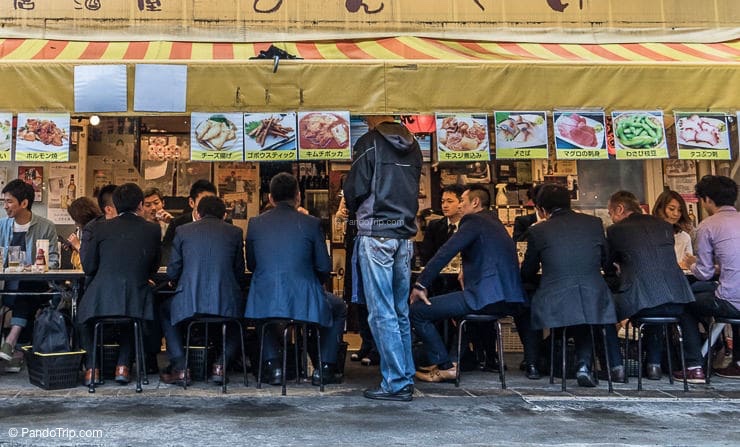
People have dinner at Izakaya, Hoppy Dori Street, Asakusa
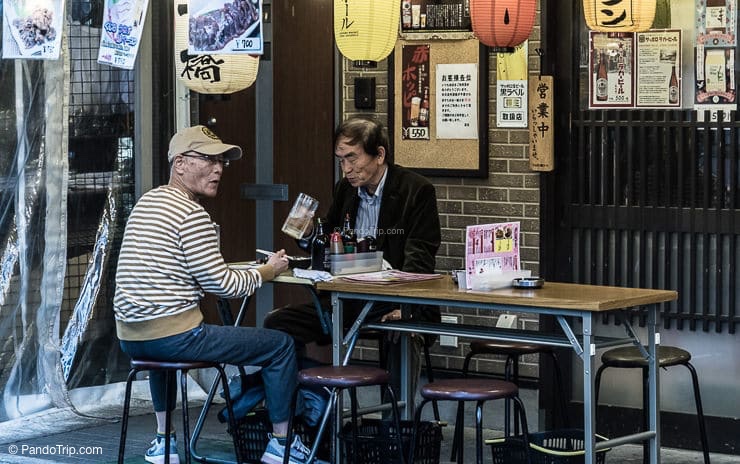
People at Japanese Izakayas, Hoppy Dori Street in Asakusa
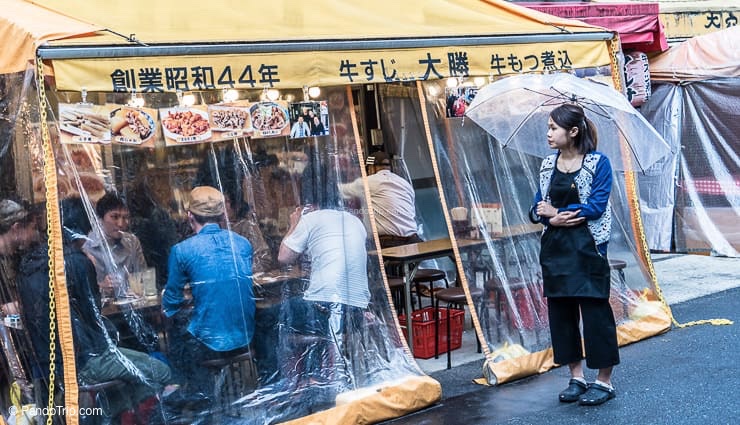
Japanese Izakayas at Hoppy Dori Street
13. Go shopping in Kitchen Town (Kappabashi)
Looking for another reason to call Tokyo a world-class shopping hub? Well, look no further than Kappabashi, otherwise called Kitchen Town, and located on the border of Asakusa and Ueno. This district, created with the intention of stocking supplies for Tokyo restaurateurs, can be just as lucrative for casual visitors as it is for serious buyers. Here you can find any and everything food related, from chopsticks and woks to Western-style oven mitts and novelty kitchen goods. Oh, and those funny plastic “sample plates” sometimes sitting in the windows of Tokyo eateries? Almost certainly bought in Kitchen Town.
Kappabashi’s name comes from an old tradition of its residents hanging their raincoats (kappa) out to dry on the nearby bridge (bashi). However, because Kappa also refers to a mystical sea-sprite, you’ll also find (and be able to snap some great photos with) statues and sculptures in homage to the street’s favorite sea monster as far as the eye can see. That is just one way that the neighborhood remains as vibrant as its name’s origin and serves as the perfect place to pick up some world class ceramics or souvenirs.
Pro-tip: Since it’s located on the edge of Asakusa, Kappabashi is a great place for a stroll after a visit to Senso-ji temple, and before a stop in the lovely Ueno Park.
Working Hours: Open Daily, 10:00 am – 5:00 pm (most stores). Many shops are closed on Sundays and public holidays.
Website: www.kappabashi.or.jp
Location on Map: Kappabashi Dogu Street
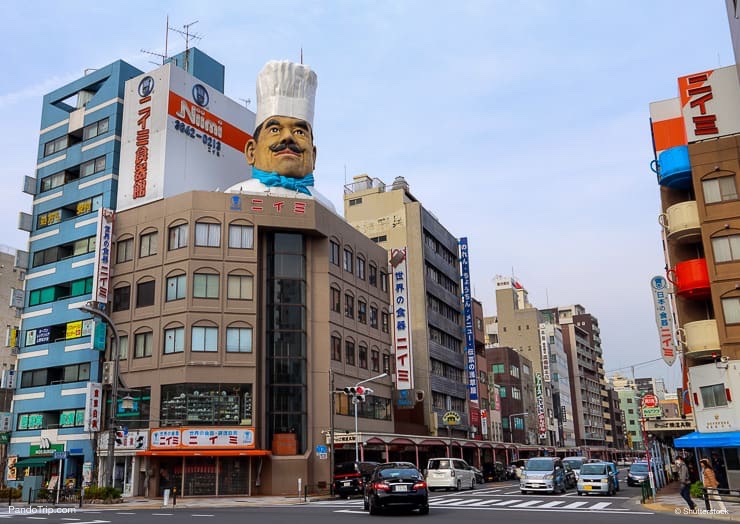
Kitchen Town or Kappabashi, Asakusa, Tokyo
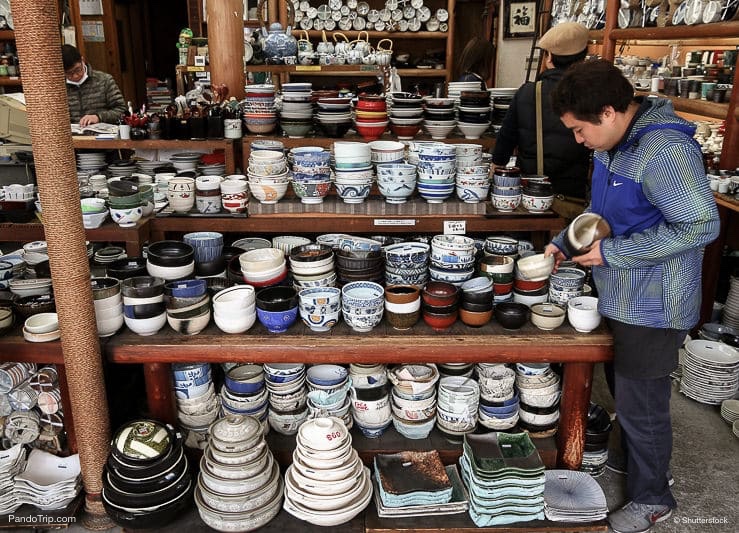
Japanese ceramic tableware store in Kappabashi, Asakusa
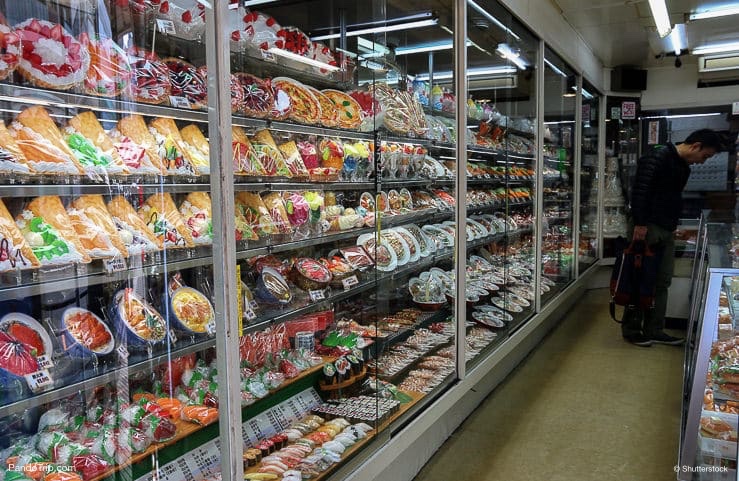
Plastic food store in Kappabashi, Asakusa
14. Try Osaka Okonomiyaki at Sometaro
Here’s another fun Japanese word for you: Okonomiyaki. Say that one three times fast to a stranger on the street, and he’ll point you in the direction of a number of restaurants specializing in this Japanese style savory pancake, which originated in Hiroshima and Kansai, but which has taken all of Japan by storm. The name translated roughly to “what you like grilled” and they mean that! Okonomiyaki can be made with a ton of different ingredients, from green onions to pork to seafood to almost anything else you can think of. For this reason, okonomiyaki is sometimes called Japanese Pizza.
Now, if you’re thinking to yourself, “where can I find such a delicious treat?” we recommend the classic Okonomiyaki eatery Sometaro, which is based in Asakusa and has been operating since 1937. Though visitors to this famous eatery will likely find themselves amongst more tourists than locals, what makes Sometaro special is not really its authenticity, but rather its fun factor, because patrons of the restaurant get to made their own Okonomiyaki! That’s right, from picking the ingredients to grilling it yourself, Sometaro provides a unique insight into the ways of Okonomiyaki making, by learning from the masters. And lest you think that this unique experience will break the bank, the simple Okonomiyaki costs only 380 yen, with the gourmet options capping out at 880.
Pro-tip: Because there is no “wrong” way to make Okonomiyaki, don’t be afraid to try new things, but don’t feel guilty about using tried and true flavors either. Not everyone loves kimchi, and if you don’t, there’s no sense in ruining your creation.
Working hours: Open Daily, 12:00 pm – 10:00 pm
Location on map: Sometaro
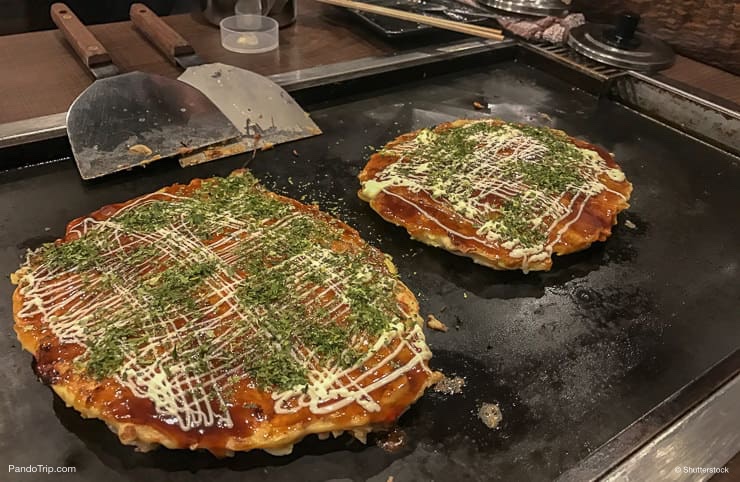
Finished, freshly made Okonomiyaki
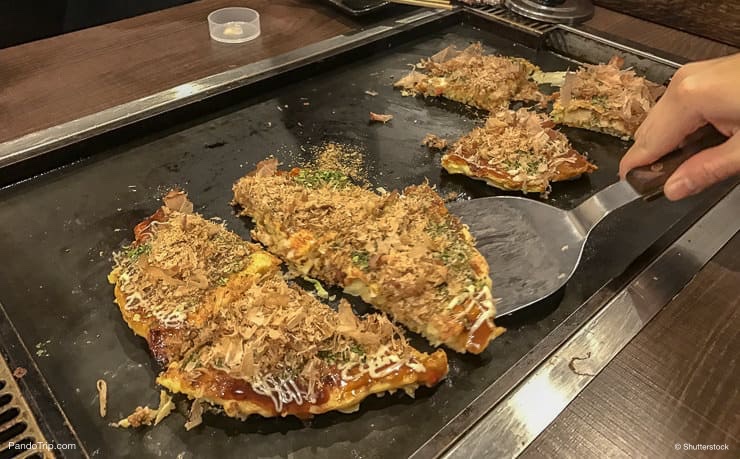
Making traditional Japanese Okonomiyaki
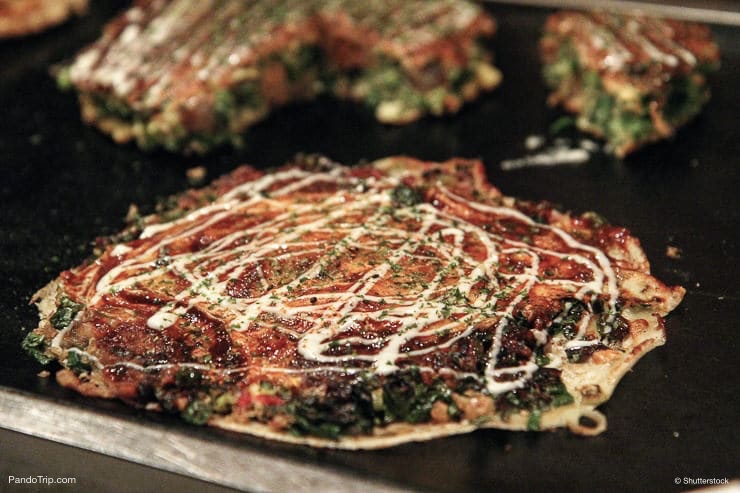
Okonomiyaki or Japanese Pizza
15. Ride some retro roller coasters in Hanayashiki Amusement Park
Listen up, roller coaster fans. We’ve saved this last one just for you. For many visitors to Tokyo, the name Hanayashiki doesn’t ring a bell. But for fun-seekers and lovers of all things retro? It’s a different story. Hanayashiki is the oldest amusement park in Japan, and boasts a pleasantly nostalgic atmosphere that can be fun for children and adults alike. Originally opened in 1853 as a flower park (hana means flower in Japanese) the park has grown and expanded into the amusement palace it is today.
Located just steps from the Senso-ji temple, Hanayashiki feels like the other side of the coin as far as historical attractions are concerned. Where Senso-ji is ornate, beautiful and solemn, Hanayashiki is fun, free-spirited and cheerful, all while showing off the technological advances that defined an era now bygone. And for those looking for an experience more cultural than flat-out fun? Hanayashiki also boasts an array of “cultural” activities, from tea ceremonies to kimono and ninja experiences.
Pro-tip: After the admission price, visitors can also buy free ride passes that allow them to go on any ride they please, as many times as they want. However, because not all attractions will appeal to all guests, we recommend buying tickets for rides as needed instead of wasting money on the day pass.
Working hours: Open Daily, 10:00 am – 6:00 pm
Admission: 1,000 yen (Adults), 500 yen (Children)
Website: www.hanayashiki.net
Location on map: Hanayashiki Amusement Park
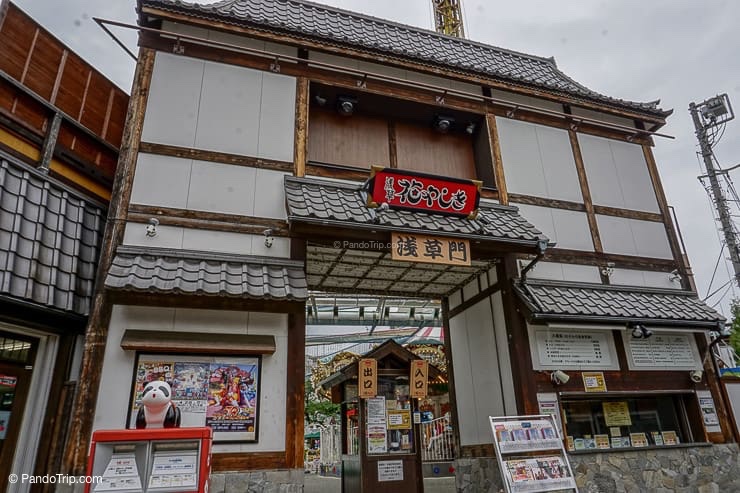
Hanayashiki Amusement Park in Asakusa, Tokyo
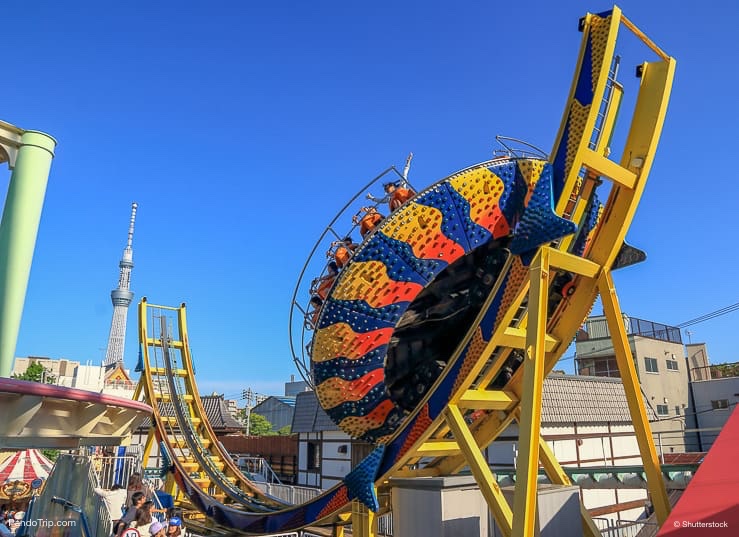
Disk O ride at Hanayashiki Amusement Park
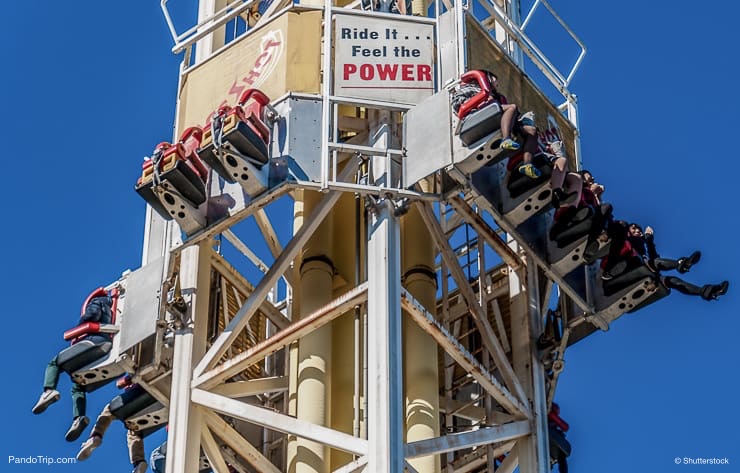
The Space Shot tower ride at Hanayashiki Amusement Park in Asakusa, Tokyo
